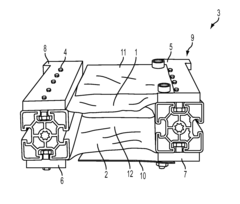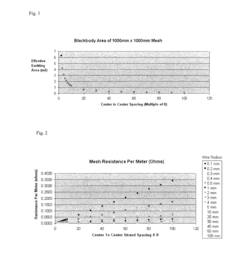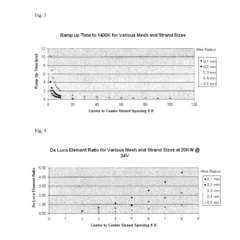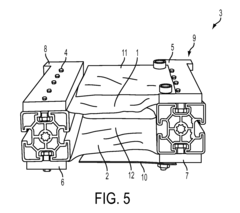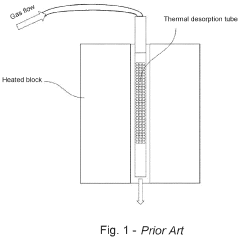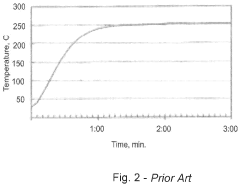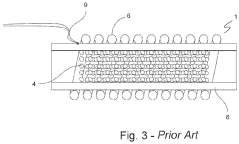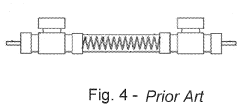How Nichrome Wire Supports Precision Measurement Devices?
JUL 11, 20259 MIN READ
Generate Your Research Report Instantly with AI Agent
Patsnap Eureka helps you evaluate technical feasibility & market potential.
Nichrome Wire Evolution
Nichrome wire, an alloy primarily composed of nickel and chromium, has undergone significant evolution since its inception in the early 20th century. Initially developed for its high electrical resistance and heat-resistant properties, nichrome wire has become an integral component in precision measurement devices.
The evolution of nichrome wire began with its use in heating elements, where its stability at high temperatures made it ideal for applications such as toasters and hair dryers. As manufacturing processes improved, the consistency and purity of nichrome wire increased, opening up new possibilities for its use in more precise applications.
In the 1950s and 1960s, the potential of nichrome wire in measurement devices began to be explored. Its low temperature coefficient of resistance made it particularly suitable for strain gauges and other sensors that required stable electrical properties across a range of temperatures. This characteristic allowed for more accurate measurements in various environmental conditions.
The 1970s and 1980s saw further refinements in nichrome wire production, with tighter controls on composition and dimensional tolerances. These improvements enabled the creation of more sensitive and accurate measurement devices, particularly in the field of temperature sensing. Nichrome wire became a key component in thermocouples and resistance temperature detectors (RTDs), offering improved stability and repeatability in temperature measurements.
As precision manufacturing techniques advanced in the 1990s and 2000s, nichrome wire could be produced in increasingly fine gauges and with even greater consistency. This allowed for the development of miniaturized sensors and more compact measurement devices. The ability to create ultra-thin nichrome wires also expanded its use in microelectromechanical systems (MEMS) and other nanotechnology applications.
In recent years, the evolution of nichrome wire has focused on enhancing its properties through advanced alloying techniques and surface treatments. These developments have led to nichrome wires with improved corrosion resistance, higher temperature stability, and even greater precision in electrical resistance. Such advancements have further expanded the wire's utility in cutting-edge measurement technologies, including those used in aerospace, medical diagnostics, and scientific research.
The ongoing evolution of nichrome wire continues to push the boundaries of precision measurement. Current research is exploring the potential of nichrome-based nanostructures and composite materials, which may offer even greater sensitivity and stability in future measurement devices. As technology progresses, nichrome wire remains a crucial element in the quest for ever more accurate and reliable measurements across a wide range of industries and applications.
The evolution of nichrome wire began with its use in heating elements, where its stability at high temperatures made it ideal for applications such as toasters and hair dryers. As manufacturing processes improved, the consistency and purity of nichrome wire increased, opening up new possibilities for its use in more precise applications.
In the 1950s and 1960s, the potential of nichrome wire in measurement devices began to be explored. Its low temperature coefficient of resistance made it particularly suitable for strain gauges and other sensors that required stable electrical properties across a range of temperatures. This characteristic allowed for more accurate measurements in various environmental conditions.
The 1970s and 1980s saw further refinements in nichrome wire production, with tighter controls on composition and dimensional tolerances. These improvements enabled the creation of more sensitive and accurate measurement devices, particularly in the field of temperature sensing. Nichrome wire became a key component in thermocouples and resistance temperature detectors (RTDs), offering improved stability and repeatability in temperature measurements.
As precision manufacturing techniques advanced in the 1990s and 2000s, nichrome wire could be produced in increasingly fine gauges and with even greater consistency. This allowed for the development of miniaturized sensors and more compact measurement devices. The ability to create ultra-thin nichrome wires also expanded its use in microelectromechanical systems (MEMS) and other nanotechnology applications.
In recent years, the evolution of nichrome wire has focused on enhancing its properties through advanced alloying techniques and surface treatments. These developments have led to nichrome wires with improved corrosion resistance, higher temperature stability, and even greater precision in electrical resistance. Such advancements have further expanded the wire's utility in cutting-edge measurement technologies, including those used in aerospace, medical diagnostics, and scientific research.
The ongoing evolution of nichrome wire continues to push the boundaries of precision measurement. Current research is exploring the potential of nichrome-based nanostructures and composite materials, which may offer even greater sensitivity and stability in future measurement devices. As technology progresses, nichrome wire remains a crucial element in the quest for ever more accurate and reliable measurements across a wide range of industries and applications.
Precision Measurement Market Analysis
The precision measurement market has been experiencing significant growth in recent years, driven by increasing demand for accurate and reliable measurement devices across various industries. This market encompasses a wide range of instruments and technologies, including those that utilize nichrome wire for their functionality.
The global precision measurement market was valued at approximately $25 billion in 2020 and is projected to reach $36 billion by 2026, growing at a CAGR of around 6% during the forecast period. This growth is attributed to several factors, including the rising adoption of automation in manufacturing processes, stringent quality control requirements, and the increasing need for precise measurements in research and development activities.
Key industries driving the demand for precision measurement devices include automotive, aerospace, electronics, healthcare, and manufacturing. In the automotive sector, for instance, the need for high-precision measurements in engine components and safety systems has led to increased adoption of advanced measurement technologies. Similarly, the aerospace industry relies heavily on precision measurement devices for ensuring the accuracy of critical components and systems.
The electronics industry, particularly semiconductor manufacturing, represents a significant market for precision measurement devices. As electronic components continue to shrink in size and increase in complexity, the demand for highly accurate measurement tools has grown exponentially. This trend is expected to continue as the industry moves towards more advanced technologies such as 5G, Internet of Things (IoT), and artificial intelligence (AI).
Geographically, North America and Europe currently dominate the precision measurement market, owing to the presence of established manufacturing industries and high investment in research and development. However, the Asia-Pacific region is expected to witness the highest growth rate in the coming years, driven by rapid industrialization, increasing adoption of automation, and growing investment in infrastructure development.
The market is characterized by intense competition among key players, including Hexagon AB, Renishaw plc, Mitutoyo Corporation, and Mettler-Toledo International Inc. These companies are continuously investing in research and development to introduce innovative products and maintain their market position. The increasing focus on Industry 4.0 and smart manufacturing is expected to create new opportunities for precision measurement device manufacturers, particularly in the development of connected and IoT-enabled measurement solutions.
In the context of nichrome wire-based precision measurement devices, the market is seeing a growing demand for temperature sensors, strain gauges, and resistance thermometers. These devices leverage the unique properties of nichrome wire, such as its high resistivity and low temperature coefficient of resistance, to provide accurate and reliable measurements in various applications. As industries continue to prioritize precision and quality control, the demand for nichrome wire-supported measurement devices is expected to grow, contributing to the overall expansion of the precision measurement market.
The global precision measurement market was valued at approximately $25 billion in 2020 and is projected to reach $36 billion by 2026, growing at a CAGR of around 6% during the forecast period. This growth is attributed to several factors, including the rising adoption of automation in manufacturing processes, stringent quality control requirements, and the increasing need for precise measurements in research and development activities.
Key industries driving the demand for precision measurement devices include automotive, aerospace, electronics, healthcare, and manufacturing. In the automotive sector, for instance, the need for high-precision measurements in engine components and safety systems has led to increased adoption of advanced measurement technologies. Similarly, the aerospace industry relies heavily on precision measurement devices for ensuring the accuracy of critical components and systems.
The electronics industry, particularly semiconductor manufacturing, represents a significant market for precision measurement devices. As electronic components continue to shrink in size and increase in complexity, the demand for highly accurate measurement tools has grown exponentially. This trend is expected to continue as the industry moves towards more advanced technologies such as 5G, Internet of Things (IoT), and artificial intelligence (AI).
Geographically, North America and Europe currently dominate the precision measurement market, owing to the presence of established manufacturing industries and high investment in research and development. However, the Asia-Pacific region is expected to witness the highest growth rate in the coming years, driven by rapid industrialization, increasing adoption of automation, and growing investment in infrastructure development.
The market is characterized by intense competition among key players, including Hexagon AB, Renishaw plc, Mitutoyo Corporation, and Mettler-Toledo International Inc. These companies are continuously investing in research and development to introduce innovative products and maintain their market position. The increasing focus on Industry 4.0 and smart manufacturing is expected to create new opportunities for precision measurement device manufacturers, particularly in the development of connected and IoT-enabled measurement solutions.
In the context of nichrome wire-based precision measurement devices, the market is seeing a growing demand for temperature sensors, strain gauges, and resistance thermometers. These devices leverage the unique properties of nichrome wire, such as its high resistivity and low temperature coefficient of resistance, to provide accurate and reliable measurements in various applications. As industries continue to prioritize precision and quality control, the demand for nichrome wire-supported measurement devices is expected to grow, contributing to the overall expansion of the precision measurement market.
Nichrome Wire Technical Challenges
Nichrome wire, despite its widespread use in precision measurement devices, faces several technical challenges that impact its performance and reliability. One of the primary issues is temperature sensitivity, which can lead to inaccurate readings in environments with fluctuating temperatures. The wire's resistance changes with temperature, necessitating complex compensation mechanisms to maintain measurement accuracy across varying conditions.
Another significant challenge is the wire's susceptibility to oxidation, particularly at high temperatures. This oxidation can alter the wire's electrical properties over time, potentially compromising the long-term stability and accuracy of the measurement devices. Manufacturers must implement protective measures or periodic calibration routines to mitigate this issue.
The mechanical properties of nichrome wire also present challenges in certain applications. While the wire is relatively strong, it can still be prone to fatigue and breakage under repeated stress or vibration. This is particularly problematic in devices that require continuous or rapid movement, such as in some types of flow meters or accelerometers.
Precision in manufacturing nichrome wire to exact specifications is another technical hurdle. Achieving consistent diameter, composition, and resistance along the entire length of the wire is crucial for maintaining uniform performance across different batches of measurement devices. Even minor variations can lead to discrepancies in sensor calibration and output.
Electromagnetic interference (EMI) susceptibility is a concern in some precision measurement applications. Nichrome wire can act as an antenna, picking up external electromagnetic signals that introduce noise into the measurements. Shielding and proper circuit design are necessary to minimize this effect, adding complexity to device construction.
The relatively high cost of nichrome compared to other conductive materials can be a limiting factor in some applications, especially for large-scale or cost-sensitive productions. This economic consideration often drives research into alternative materials or wire configurations that can offer similar performance at a lower cost.
Lastly, the integration of nichrome wire into miniaturized or flexible devices poses unique challenges. As measurement devices become smaller and more versatile, maintaining the wire's performance characteristics while adapting to new form factors requires innovative design solutions and manufacturing techniques.
Another significant challenge is the wire's susceptibility to oxidation, particularly at high temperatures. This oxidation can alter the wire's electrical properties over time, potentially compromising the long-term stability and accuracy of the measurement devices. Manufacturers must implement protective measures or periodic calibration routines to mitigate this issue.
The mechanical properties of nichrome wire also present challenges in certain applications. While the wire is relatively strong, it can still be prone to fatigue and breakage under repeated stress or vibration. This is particularly problematic in devices that require continuous or rapid movement, such as in some types of flow meters or accelerometers.
Precision in manufacturing nichrome wire to exact specifications is another technical hurdle. Achieving consistent diameter, composition, and resistance along the entire length of the wire is crucial for maintaining uniform performance across different batches of measurement devices. Even minor variations can lead to discrepancies in sensor calibration and output.
Electromagnetic interference (EMI) susceptibility is a concern in some precision measurement applications. Nichrome wire can act as an antenna, picking up external electromagnetic signals that introduce noise into the measurements. Shielding and proper circuit design are necessary to minimize this effect, adding complexity to device construction.
The relatively high cost of nichrome compared to other conductive materials can be a limiting factor in some applications, especially for large-scale or cost-sensitive productions. This economic consideration often drives research into alternative materials or wire configurations that can offer similar performance at a lower cost.
Lastly, the integration of nichrome wire into miniaturized or flexible devices poses unique challenges. As measurement devices become smaller and more versatile, maintaining the wire's performance characteristics while adapting to new form factors requires innovative design solutions and manufacturing techniques.
Current Nichrome Wire Applications
01 Precision manufacturing of nichrome wire
Advanced techniques for producing high-precision nichrome wire, including controlled drawing processes, heat treatments, and surface finishing methods to achieve precise dimensions and uniform properties.- Precision manufacturing of nichrome wire: Advanced manufacturing techniques are employed to produce high-precision nichrome wire. These methods focus on controlling the wire's diameter, composition, and surface quality to ensure consistent electrical properties and performance in various applications.
- Nichrome wire in heating elements: Nichrome wire is widely used in heating elements due to its high resistance and temperature stability. Precision-manufactured nichrome wire allows for accurate temperature control and uniform heat distribution in various heating applications, including industrial heaters and household appliances.
- Nichrome wire in sensor applications: High-precision nichrome wire is utilized in various sensor applications, such as strain gauges and temperature sensors. The wire's consistent electrical properties and dimensional accuracy contribute to improved sensor performance and reliability in measuring physical quantities.
- Surface treatment of nichrome wire: Surface treatment techniques are applied to nichrome wire to enhance its properties and performance. These treatments may include coating, oxidation, or other processes to improve corrosion resistance, electrical conductivity, or adhesion to other materials in specific applications.
- Precision control of nichrome wire composition: The composition of nichrome wire is precisely controlled during manufacturing to achieve specific electrical and mechanical properties. This includes adjusting the ratio of nickel and chromium, as well as incorporating other alloying elements to optimize the wire's performance for different applications.
02 Nichrome wire composition optimization
Development of specialized nichrome alloy compositions to enhance specific properties such as resistivity, temperature coefficient of resistance, and mechanical strength for improved precision in various applications.Expand Specific Solutions03 Precision winding and coiling techniques
Innovative methods for winding and coiling nichrome wire with high precision, including automated systems and tension control mechanisms to ensure consistent spacing and geometry in heating elements and sensors.Expand Specific Solutions04 Quality control and testing of nichrome wire
Advanced quality control processes and testing methodologies to ensure the precision and reliability of nichrome wire, including non-destructive testing, electrical property measurements, and dimensional accuracy verification.Expand Specific Solutions05 Precision applications of nichrome wire
Utilization of high-precision nichrome wire in specialized applications such as microheaters, precision resistors, and thin-film sensors, leveraging its unique properties for accurate temperature control and resistance measurement.Expand Specific Solutions
Key Nichrome Wire Manufacturers
The market for precision measurement devices utilizing nichrome wire is in a mature stage, with established players and steady growth. The global market size for these devices is estimated to be in the billions of dollars, driven by demand across industries like electronics, automotive, and aerospace. Technologically, nichrome wire applications in precision measurements are well-developed, with ongoing incremental improvements. Key players like Heraeus Precious Metals, Bekaert SA, and Sumitomo Electric Industries lead in nichrome wire production, while companies such as Hon Hai Precision Industry and BSH Hausgeräte leverage the technology in their measurement devices. Continuous innovation in materials and manufacturing processes by these firms maintains the competitiveness of nichrome-based precision measurement solutions.
Heraeus Precious Metals GmbH & Co. KG (New)
Technical Solution: Heraeus has developed advanced Nichrome wire solutions for precision measurement devices. Their technology utilizes a unique composition of 80% nickel and 20% chromium, providing excellent stability and resistance to oxidation at high temperatures[1]. The company's Nichrome wires feature precise diameter control down to ±0.0001 mm, ensuring consistent electrical resistance across the wire length[2]. Heraeus employs a proprietary annealing process that enhances the wire's mechanical properties, reducing drift and improving long-term stability in measurement applications[3]. Their Nichrome wires are extensively used in thermocouples, strain gauges, and high-precision resistors for scientific instruments.
Strengths: Superior temperature stability, excellent oxidation resistance, and precise dimensional control. Weaknesses: Higher cost compared to standard alloys, limited flexibility in extreme bending applications.
Sumitomo Electric Industries Ltd.
Technical Solution: Sumitomo Electric has innovated in Nichrome wire technology for precision measurement devices. Their approach involves a micro-alloying technique that introduces trace elements to enhance the wire's electrical and mechanical properties[4]. The company's Nichrome wires feature a unique surface treatment that improves adhesion in sensor applications, reducing signal noise and increasing measurement accuracy[5]. Sumitomo's manufacturing process includes multiple drawing stages and controlled cooling, resulting in wires with exceptional uniformity and reduced internal stresses[6]. These wires are particularly suited for high-precision load cells, pressure sensors, and advanced flow meters in industrial and scientific applications.
Strengths: Enhanced electrical stability, improved sensor adhesion, and high uniformity. Weaknesses: Specialized production process may lead to higher costs, potential limitations in extreme temperature applications.
Nichrome Wire Properties Analysis
Wire mesh thermal radiative element and use in a radiative oven
PatentInactiveUS20150184867A1
Innovation
- A resistive mesh element with a calibrated De Luca Element Ratio, using nichrome wire with a specific strand diameter and spacing, operates at 24V to achieve efficient heat distribution and rapid temperature rise, allowing for quick cooking times while being cost-effective and easy to assemble.
Thermal Desorption Tube for Portable, Battery-Powered Field Analyzer or Line-Powered Analyzer
PatentActiveUS20210088425A1
Innovation
- A thermal desorption tube with an embedded heating element made from a metal with a high Resistance Temperature Coefficient (RTC) value, allowing for precise temperature control by measuring electrical current and voltage drop, ensuring rapid and energy-efficient heating of the sorbent material without overheating.
Nichrome Wire Quality Control
Quality control is a critical aspect of nichrome wire production, especially when the wire is intended for use in precision measurement devices. The manufacturing process of nichrome wire requires stringent oversight to ensure consistent performance and reliability in high-precision applications.
One of the primary quality control measures involves monitoring the composition of the nichrome alloy. The typical composition of nichrome wire consists of approximately 80% nickel and 20% chromium, with small amounts of other elements such as silicon and manganese. Precise control of these proportions is essential, as even slight variations can significantly affect the wire's electrical and mechanical properties. Manufacturers employ advanced spectrometric techniques to verify the alloy composition at various stages of production.
The dimensional consistency of nichrome wire is another crucial quality control factor. Precision measurement devices often rely on the wire's uniform cross-sectional area and diameter. To maintain tight tolerances, manufacturers utilize laser micrometer systems and optical comparators to continuously measure and adjust the wire drawing process. This ensures that the wire diameter remains within specified limits, typically with tolerances as low as ±0.0001 inches.
Surface quality is equally important in nichrome wire production. Imperfections such as scratches, pits, or inclusions can compromise the wire's performance in precision instruments. Quality control procedures include visual inspections using high-magnification microscopes and automated surface defect detection systems. These methods help identify and eliminate any surface anomalies that could affect the wire's functionality or longevity.
The electrical properties of nichrome wire, particularly its resistance, are carefully monitored throughout the production process. Inline resistance measurement systems are employed to verify that the wire's electrical characteristics meet the required specifications. This is crucial for applications where the wire serves as a sensing element or heating component in precision devices.
Thermal stability is another key attribute that undergoes rigorous quality control. Nichrome wire used in precision measurement devices must maintain consistent properties across a wide temperature range. Manufacturers conduct thermal cycling tests and monitor the wire's resistance changes under various temperature conditions to ensure its stability and reliability in demanding applications.
Lastly, quality control measures extend to the packaging and handling of nichrome wire. Clean room environments are often used for final inspection and packaging to prevent contamination. Proper spooling techniques are employed to avoid introducing stress or deformation in the wire, which could affect its performance in precision instruments.
One of the primary quality control measures involves monitoring the composition of the nichrome alloy. The typical composition of nichrome wire consists of approximately 80% nickel and 20% chromium, with small amounts of other elements such as silicon and manganese. Precise control of these proportions is essential, as even slight variations can significantly affect the wire's electrical and mechanical properties. Manufacturers employ advanced spectrometric techniques to verify the alloy composition at various stages of production.
The dimensional consistency of nichrome wire is another crucial quality control factor. Precision measurement devices often rely on the wire's uniform cross-sectional area and diameter. To maintain tight tolerances, manufacturers utilize laser micrometer systems and optical comparators to continuously measure and adjust the wire drawing process. This ensures that the wire diameter remains within specified limits, typically with tolerances as low as ±0.0001 inches.
Surface quality is equally important in nichrome wire production. Imperfections such as scratches, pits, or inclusions can compromise the wire's performance in precision instruments. Quality control procedures include visual inspections using high-magnification microscopes and automated surface defect detection systems. These methods help identify and eliminate any surface anomalies that could affect the wire's functionality or longevity.
The electrical properties of nichrome wire, particularly its resistance, are carefully monitored throughout the production process. Inline resistance measurement systems are employed to verify that the wire's electrical characteristics meet the required specifications. This is crucial for applications where the wire serves as a sensing element or heating component in precision devices.
Thermal stability is another key attribute that undergoes rigorous quality control. Nichrome wire used in precision measurement devices must maintain consistent properties across a wide temperature range. Manufacturers conduct thermal cycling tests and monitor the wire's resistance changes under various temperature conditions to ensure its stability and reliability in demanding applications.
Lastly, quality control measures extend to the packaging and handling of nichrome wire. Clean room environments are often used for final inspection and packaging to prevent contamination. Proper spooling techniques are employed to avoid introducing stress or deformation in the wire, which could affect its performance in precision instruments.
Environmental Impact of Nichrome
The environmental impact of nichrome wire in precision measurement devices is a crucial consideration in the context of sustainable technology development. Nichrome, an alloy primarily composed of nickel and chromium, offers excellent electrical and thermal properties, making it ideal for various applications in measurement instruments. However, its production, use, and disposal present several environmental challenges that warrant careful examination.
The mining and processing of nickel and chromium, the primary components of nichrome, have significant environmental implications. These activities often lead to habitat destruction, soil erosion, and water pollution. The extraction process can release harmful substances into the environment, potentially affecting local ecosystems and biodiversity. Furthermore, the energy-intensive nature of metal refining contributes to increased carbon emissions, exacerbating climate change concerns.
During the manufacturing of nichrome wire, the production process may involve the use of chemicals and generate waste materials that require proper handling and disposal. Improper management of these byproducts can lead to soil and water contamination, posing risks to both human health and the environment. Additionally, the energy consumption associated with wire production contributes to the overall carbon footprint of precision measurement devices.
In the operational phase, nichrome wire in measurement devices generally has a minimal direct environmental impact due to its durability and long lifespan. However, the indirect environmental effects stem from the energy consumption of the devices it supports. Improving the energy efficiency of these instruments can help mitigate this impact, and nichrome's properties often contribute to such improvements.
The end-of-life stage of nichrome-containing devices presents another environmental challenge. While nichrome itself is recyclable, the complex nature of precision instruments often makes recycling difficult. Improper disposal can lead to the release of heavy metals into the environment, potentially contaminating soil and water sources. Developing effective recycling and disposal methods for these devices is crucial to minimize their environmental footprint.
To address these environmental concerns, several strategies can be implemented. These include optimizing mining and production processes to reduce waste and energy consumption, developing more efficient recycling techniques for nichrome-containing devices, and exploring alternative materials with similar properties but lower environmental impact. Additionally, designing precision measurement devices for easier disassembly and component separation can facilitate more effective recycling at the end of their lifecycle.
In conclusion, while nichrome wire plays a vital role in precision measurement devices, its environmental impact throughout its lifecycle necessitates ongoing research and innovation. Balancing the technical benefits of nichrome with environmental sustainability remains a key challenge for the industry, driving the need for more eco-friendly practices in material production, device manufacturing, and waste management.
The mining and processing of nickel and chromium, the primary components of nichrome, have significant environmental implications. These activities often lead to habitat destruction, soil erosion, and water pollution. The extraction process can release harmful substances into the environment, potentially affecting local ecosystems and biodiversity. Furthermore, the energy-intensive nature of metal refining contributes to increased carbon emissions, exacerbating climate change concerns.
During the manufacturing of nichrome wire, the production process may involve the use of chemicals and generate waste materials that require proper handling and disposal. Improper management of these byproducts can lead to soil and water contamination, posing risks to both human health and the environment. Additionally, the energy consumption associated with wire production contributes to the overall carbon footprint of precision measurement devices.
In the operational phase, nichrome wire in measurement devices generally has a minimal direct environmental impact due to its durability and long lifespan. However, the indirect environmental effects stem from the energy consumption of the devices it supports. Improving the energy efficiency of these instruments can help mitigate this impact, and nichrome's properties often contribute to such improvements.
The end-of-life stage of nichrome-containing devices presents another environmental challenge. While nichrome itself is recyclable, the complex nature of precision instruments often makes recycling difficult. Improper disposal can lead to the release of heavy metals into the environment, potentially contaminating soil and water sources. Developing effective recycling and disposal methods for these devices is crucial to minimize their environmental footprint.
To address these environmental concerns, several strategies can be implemented. These include optimizing mining and production processes to reduce waste and energy consumption, developing more efficient recycling techniques for nichrome-containing devices, and exploring alternative materials with similar properties but lower environmental impact. Additionally, designing precision measurement devices for easier disassembly and component separation can facilitate more effective recycling at the end of their lifecycle.
In conclusion, while nichrome wire plays a vital role in precision measurement devices, its environmental impact throughout its lifecycle necessitates ongoing research and innovation. Balancing the technical benefits of nichrome with environmental sustainability remains a key challenge for the industry, driving the need for more eco-friendly practices in material production, device manufacturing, and waste management.
Unlock deeper insights with Patsnap Eureka Quick Research — get a full tech report to explore trends and direct your research. Try now!
Generate Your Research Report Instantly with AI Agent
Supercharge your innovation with Patsnap Eureka AI Agent Platform!
